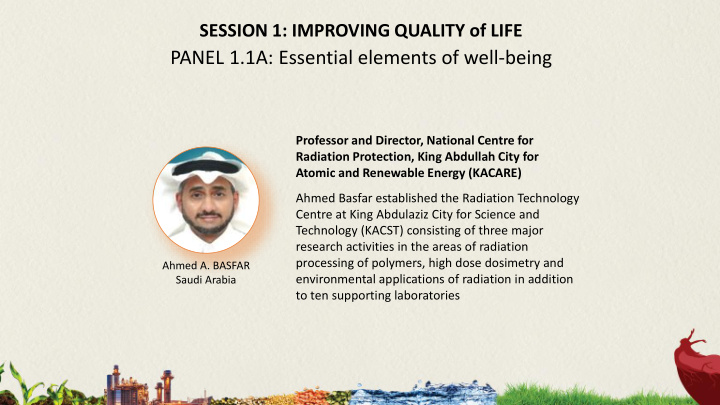



SESSION 1: IMPROVING QUALITY of LIFE PANEL 1.1A: Essential elements of well-being Professor and Director, National Centre for Radiation Protection, King Abdullah City for Atomic and Renewable Energy (KACARE) Ahmed Basfar established the Radiation Technology Centre at King Abdulaziz City for Science and Technology (KACST) consisting of three major research activities in the areas of radiation processing of polymers, high dose dosimetry and Ahmed A. BASFAR environmental applications of radiation in addition Saudi Arabia to ten supporting laboratories
Application of Ionizing Radiation in Environment Protection Prof. Dr. Ahmed Basfar King Abdullah City for Atomic and Renewable Energy (KACARE) Riyadh Saudi Arabia IAEA Ministerial Conference on Nuclear Science and Technology, Vienna 28-30 November, 2018 https://www.kacare.gov.sa/
Emission of Pollutants and Acidic Rain
General Scheme of the Electron Beam Interaction with the Flue Gas
Japanese Experience of EBFGT Technology Development JAERI / Takasaki RCRE and Ebara Co. in 1972 Small flow type plant (60Nm3/h) Removal:SO 2 80%;NO x 90% IAEA-TM, Warsaw, May, 2007 S.Machi
Dependence of SO 2 and NO x Removal Efficiency on Dose 100 90 SO2 80 70 Removal [%] 60 50 NOx 40 30 20 10 0 5,0 5,5 6,0 6,5 7,0 7,5 8,0 8,5 9,0 9,5 10,0 Dose [kGy] Pomorzany, Poland 1999 (IAEA/EPS/INCT) 270,000Nm 3 /h(130MW) Flow gas flow (coal-fired) Flue gas temperature 130-150 ℃ 1000~1500/400~600mg/Nm 3 SO2/NOx Conc. SO2/NOx Removal Eff. 90%/70% By-product production 200~300kg/h NH3 consumption 100~150kg/h Electron beam accelerator 800keV/4 × 300mA Total power consumption 1MW
General View of the Pilot Plant in Saudi Arabia 1. Stack of F 1001 boiler 7. Bag filter 2. Boiler F1001 8. Insulated duct part 3. Flue gas duct 9. Cyclone 4. Control room 10. Ammonia storage and injection unit 5. Humidification unit 11. EB mobile unit 6. Pilot plant stack
Pilot Plant Process Units 1. 1. Inlet to process vessel, Inlet to process vessel, 2. 2. EB-TECH mobile unit, EB-TECH mobile unit, 3. 3. Cyclone, Cyclone, 4. 4. Cartridge filter Cartridge filter 5. 5. ID fan ID fan 6. 6. Stack Stack
SO 2 and NO x Removal Efficiency
Radiation Technology for Wastewater Treatment High contamination Textile dyeing wastewater Leachate from landfill area Removal of impurities From petrochemical plant Discharge (COD, BOD, S/S etc.) From paper mills From mines (coal, metals) From chemical plants Low or less contamination Underground water Disinfection Re-use Water from lakes or marshes Removal of Color, Effluent of municipal plants Odor, Residuals
Textile Dyeing Wastewater Treatment Plant in Korea Full-scale application of electron beam wastewater treatment plant for 10,000 m 3 /d of textile dyeing waste water with 1 MeV, 400 kW accelerator.
Marine Transportation EMISSION „ Green ” dock ❖ Two stroke Diesel up to 81 MW ❖ 6 to 14 pistons ( each 1820 dm 3 ) Vibrio cholerae Enterococci Escherichia coli ❖ Heavy oil ❖ Consumption 250 ton fuel/day ❖ Typical off-gases – 13 % O 2 , 5.2% CO 2 , 5.35% H 2 O, ❖ 1500ppmv NOx, 600ppmv SOx, 60 ppmv CO, 180 ppm VOC
Conclusions ▪ EBFGT is the most advanced technology for simultaneous SOx and NOx removal ▪ Feasibility of the technology has been demonstrated for coal fired plant in the full industrial scale ▪ Feasibility of the technology has been demonstrated for oil fired boiler in pilot industrial scale ▪ The process can be applied for diesel engine flue gas treatment at cargo ships (laboratory tests) ▪ The process can be applied for VOC and PAH treatment (laboratory and industrial pilot tests) ▪ The process can be applied for mercury emission control (laboratory tests) ▪ New developments needed in accelerator technology
Challe llenges and Opportunit ities for Applic lication 1. Public Acceptance. 2. Regulatory works from Authorities. 3. Engineering Problems ? (Research to Business). 4. Penetration in water and sludge. 5.Laboratory to Commercial Plant. 6. Economics (competitions with conventional technology). 7. Socio-Economical aspects.
THANK YOU
Recommend
More recommend